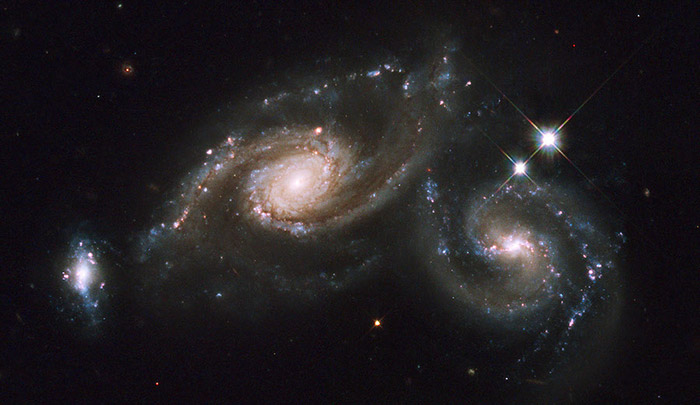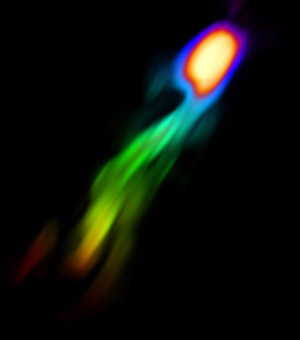Galactic Blowout
Stellar winds blast fuel for future stars far beyond galaxies
Published Date
By:
- Susan Brown
Share This:
Article Content

Gases compressed in colliding galaxies, like these of Arp 274, can ignite a firestorm of star birth. Credit: NASA, ESA, M. Livio, STScI, AURA
Stars igniting at rates rarely seen in a distant, massive galaxy are blowing cold, dense gas tens of thousands of light years into space, depleting the galaxy's supply of stellar fuel. The loss will limit future star birth, a driver galactic aging for which evidence has been mounting.
Aleks Diamond-Stanic, a former postdoc at UC San Diego, Alison Coil, a professor of physics, first suggested that star formation might drive fierce galactic winds in 2012.
Now measurements using a radio telescope in the French Alps, the IRAM Plateau de Bure Interferometer, have shown a molecular cloud shooting out from the galaxy at millions of miles per hour. About a third of the cloud —the matter from which stars are forming — is streaming out of the galaxy, a team of astrophysicists including Coil and Diamond-Stanic reports in Nature December 4.

Gas in a distant massive galaxy. A compact region of intense star formation near the center of the galaxy forms the bright ‘head.’ Radiation from the stars is propelling a large part of the cloud out of the galaxy at high velocity. Credit: Jim Geach and Rob Crain
A similar process can quench star formation as galaxies collide and cold gas floods into the merging center where it compresses and ignites in a burst of new stars. Diamond-Stanic, Coil and colleagues at other institutions recently measured the outflow of gas from a dozen pairs of merging galaxies using images from the Hubble Space Telescope.
The resulting firestorms expel gas from the galaxies at two million miles per hour, they reported in the Monthly Notices of the Royal Astronomical Society last summer.
“The biggest surprise from Hubble was the realization that the newly formed stars were born so close together,” said Diamond-Stanic, who is now at the University of Wisconsin-Madison. “The extreme physical conditions at the centers of these galaxies explain how they can expel gas at millions of miles per hour.”
With little fuel left, the merged galaxies quickly grow old as the blue light of new stars gives way to the red light of aging stars in just a few tens of millions of years.
Share This:
You May Also Like
UC San Diego is Strengthening U.S. Semiconductor Innovation and Workforce Development
Technology & EngineeringStay in the Know
Keep up with all the latest from UC San Diego. Subscribe to the newsletter today.



